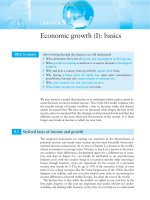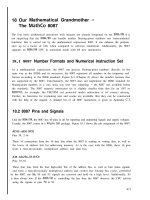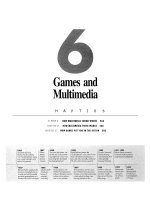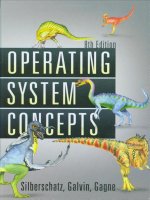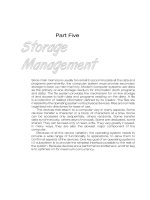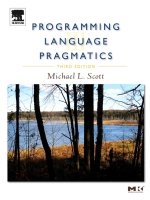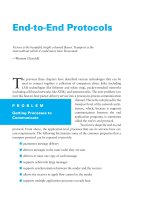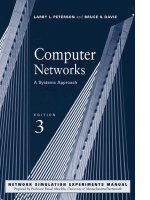Ebook Programing language pragmatics (3rd edition) Part 2
Bạn đang xem bản rút gọn của tài liệu. Xem và tải ngay bản đầy đủ của tài liệu tại đây (6.83 MB, 409 trang )
III
Alternative Programming Models
As we noted in Chapter 1, programming languages are traditionally though imperfectly classified into various imperative and declarative families. We have had occasion in Parts I and II
to mention issues of particular importance to each of the major families. Moreover much
of what we have covered—syntax, semantics, naming, types, abstraction—applies uniformly
to all. Still, our attention has focused mostly on mainstream imperative languages. In Part III
we shift this focus.
Functional and logic languages are the principal nonimperative options. We consider them
in Chapters 10 and 11, respectively. In each case we structure our discussion around a representative language: Scheme for functional programming, Prolog for logic programming. In
Chapter 10 we also cover eager and lazy evaluation, and first-class and higher-order functions.
In Chapter 11 we cover issues that make fully automatic, general purpose logic programming
difficult, and describe restrictions used in practice to keep the model tractable. Optional sections in both chapters consider mathematical foundations: Lambda Calculus for functional
programming, Predicate Calculus for logic programming.
The remaining two chapters consider concurrent and scripting models, both of which are
increasingly popular, and cut across the imperative/declarative divide. Concurrency is driven
by the hardware parallelism of internetworked computers and by the coming explosion in
multithreaded processors and chip-level multiprocessors. Scripting is driven by the growth of
the World Wide Web and by an increasing emphasis on programmer productivity, which places
rapid development and reusability above sheer run-time performance.
Chapter 12 begins with the fundamentals of concurrency, including communication and
synchronization, thread creation syntax, and the implementation of threads. The remainder
of the chapter is divided between shared-memory models, in which threads use explicit or
implicit synchronization mechanisms to manage a common set of variables, and messagepassing models, in which threads interact only through explicit communication.
The first half of Chapter 13 surveys problem domains in which scripting plays a major role:
shell (command) languages, text processing and report generation, mathematics and statistics,
the “gluing” together of program components, extension mechanisms for complex applications,
and client and server-side Web scripting. The second half considers some of the more important language innovations championed by scripting languages: flexible scoping and naming
conventions, string and pattern manipulation (extended regular expressions), and high level
data types.
This page intentionally left blank
10
Functional Languages
Previous chapters of this text have focused largely on imperative
programming languages. In the current chapter and the next we emphasize functional and logic languages instead. While imperative languages are far more widely
used, “industrial-strength” implementations exist for both functional and logic
languages, and both models have commercially important applications. Lisp has
traditionally been popular for the manipulation of symbolic data, particularly in
the field of artificial intelligence. In recent years functional languages—statically
typed ones in particular—have become increasingly popular for scientific and
business applications as well. Logic languages are widely used for formal specifications and theorem proving and, less widely, for many other applications.
Of course, functional and logic languages have a great deal in common with
their imperative cousins. Naming and scoping issues arise under every model.
So do types, expressions, and the control-flow concepts of selection and recursion.
All languages must be scanned, parsed, and analyzed semantically. In addition,
functional languages make heavy use of subroutines—more so even than most
von Neumann languages—and the notions of concurrency and nondeterminacy
are as common in functional and logic languages as they are in the imperative
case.
As noted in Chapter 1, the boundaries between language categories tend to
be rather fuzzy. One can write in a largely functional style in many imperative
languages, and many functional languages include imperative features (assignment and iteration). The most common logic language—Prolog—provides certain imperative features as well. Finally, it is easy to build a logic programming
system in most functional programming languages.
Because of the overlap between imperative and functional concepts, we have
had occasion several times in previous chapters to consider issues of particular importance to functional programming languages. Most such languages
depend heavily on polymorphism (the implicit parametric kind—Sections 3.5.3
and 7.2.4). Most make heavy use of lists (Section 7.8). Several, historically,
were dynamically scoped (Sections 3.3.6 and 3.4.2). All employ recursion
(Section 6.6) for repetitive execution, with the result that program behavior and performance depend heavily on the evaluation rules for parameters
Programming Language Pragmatics. DOI: 10.1016/B978-0-12-374514-9.00021-5
Copyright © 2009 by Elsevier Inc. All rights reserved.
505
506
Chapter 10 Functional Languages
(Section 6.6.2). All have a tendency to generate significant amounts of temporary data, which their implementations reclaim through garbage collection
(Section 7.7.3).
Our chapter begins with a brief introduction to the historical origins of the
imperative, functional, and logic programming models. We then enumerate fundamental concepts in functional programming and consider how these are realized
in the Scheme dialect of Lisp. More briefly, we also consider Caml, Common Lisp,
Erlang, Haskell, ML, Miranda, pH, Single Assignment C, and Sisal. We pay particular attention to issues of evaluation order and higher-order functions. For those
with an interest in the theoretical foundations of functional programming, we
provide (on the PLP CD) an introduction to functions, sets, and the lambda calculus. The formalism helps to clarify the notion of a “pure” functional language,
and illuminates the differences between the pure notation and its realization in
more practical programming languages.
10.1
Historical Origins
To understand the differences among programming models, it can be helpful to
consider their theoretical roots, all of which predate the development of electronic
computers. The imperative and functional models grew out of work undertaken
by mathematicians Alan Turing, Alonzo Church, Stephen Kleene, Emil Post, and
others in the 1930s. Working largely independently, these individuals developed
several very different formalizations of the notion of an algorithm, or effective
procedure, based on automata, symbolic manipulation, recursive function definitions, and combinatorics. Over time, these various formalizations were shown to
be equally powerful: anything that could be computed in one could be computed
in the others. This result led Church to conjecture that any intuitively appealing
model of computing would be equally powerful as well; this conjecture is known
as Church’s thesis.
Turing’s model of computing was the Turing machine, an automaton reminiscent of a finite or pushdown automaton, but with the ability to access arbitrary
cells of an unbounded storage “tape.”1 The Turing machine computes in an imperative way, by changing the values in cells of its tape, just as a high-level imperative program computes by changing the values of variables. Church’s model
of computing is called the lambda calculus. It is based on the notion of parameterized expressions (with each parameter introduced by an occurrence of the
1 Alan Turing (1912–1954), for whom the Turing Award is named, was a British mathematician,
philosopher, and computer visionary. As intellectual leader of Britain’s cryptanalytic group during
World War II, he was instrumental in cracking the German “Enigma” code and turning the tide
of the war. He also laid the theoretical foundations of modern computer science, conceived the
general purpose electronic computer, and pioneered the field of Artificial Intelligence. Persecuted
as a homosexual after the war, stripped of his security clearance, and sentenced to “treatment”
with drugs, he committed suicide.
10.2 Functional Programming Concepts
507
letter λ—hence the notation’s name).2 Lambda calculus was the inspiration for
functional programming: one uses it to compute by substituting parameters into
expressions, just as one computes in a high level functional program by passing
arguments to functions. The computing models of Kleene and Post are more
abstract, and do not lend themselves directly to implementation as a programming
language.
The goal of early work in computability was not to understand computers
(aside from purely mechanical devices, computers did not exist) but rather to
formalize the notion of an effective procedure. Over time, this work allowed
mathematicians to formalize the distinction between a constructive proof (one
that shows how to obtain a mathematical object with some desired property)
and a nonconstructive proof (one that merely shows that such an object must
exist, perhaps by contradiction, or counting arguments, or reduction to some
other theorem whose proof is nonconstructive). In effect, a program can be seen
as a constructive proof of the proposition that, given any appropriate inputs,
there exist outputs that are related to the inputs in a particular, desired way.
Euclid’s algorithm, for example, can be thought of as a constructive proof of
the proposition that every pair of non-negative integers has a greatest common
divisor.
Logic programming is also intimately tied to the notion of constructive proofs,
but at a more abstract level. Rather than write a general constructive proof that
works for all appropriate inputs, the logic programmer writes a set of axioms
that allow the computer to discover a constructive proof for each particular set of
inputs. We will consider logic programming in more detail in Chapter 11.
10.2
Functional Programming Concepts
In a strict sense of the term, functional programming defines the outputs of a
program as a mathematical function of the inputs, with no notion of internal
state, and thus no side effects. Among the languages we consider here, Miranda,
Haskell, pH, Sisal, and Single Assignment C are purely functional. Erlang is nearly
so. Most others include imperative features. To make functional programming
practical, functional languages provide a number of features that are often missing
in imperative languages, including:
First-class function values and higher-order functions
Extensive polymorphism
2 Alonzo Church (1903–1995) was a member of the mathematics faculty at Princeton University
from 1929 to 1967, and at UCLA from 1967 to 1990. While at Princeton he supervised the
doctoral theses of, among many others, Alan Turing, Stephen Kleene, Michael Rabin, and Dana
Scott. His codiscovery, with Turing, of uncomputable problems was a major breakthrough in
understanding the limits of mathematics.
508
Chapter 10 Functional Languages
List types and operators
Structured function returns
Constructors (aggregates) for structured objects
Garbage collection
In Section 3.6.2 we defined a first-class value as one that can be passed as a
parameter, returned from a subroutine, or (in a language with side effects) assigned
into a variable. Under a strict interpretation of the term, first-class status also
requires the ability to create (compute) new values at run time. In the case of subroutines, this notion of first-class status requires nested lambda expressions that
can capture values (with unlimited extent) defined in surrounding scopes. Subroutines are second-class values in most imperative languages, but first-class values
(in the strict sense of the term) in all functional programming languages. A higherorder function takes a function as an argument, or returns a function as a result.
Polymorphism is important in functional languages because it allows a function to be used on as general a class of arguments as possible. As we have seen in
Sections 7.1 and 7.2.4, Lisp and its dialects are dynamically typed, and thus inherently polymorphic, while ML and its relatives obtain polymorphism through the
mechanism of type inference. Lists are important in functional languages because
they have a natural recursive definition, and are easily manipulated by operating
on their first element and (recursively) the remainder of the list. Recursion is
important because in the absence of side effects it provides the only means of
doing anything repeatedly.
Several of the items in our list of functional language features (recursion, structured function returns, constructors, garbage collection) can be found in some
but not all imperative languages. Fortran 77 has no recursion, nor does it allow
structured types (i.e., arrays) to be returned from functions. Pascal and early
versions of Modula-2 allow only simple and pointer types to be returned from
functions. As we saw in Section 7.1.5, several imperative languages, including Ada,
C, and Fortran 90, provide aggregate constructs that allow a structured value to
be specified in-line. In most imperative languages, however, such constructs are
lacking or incomplete. C# 3.0 and several scripting languages—Python and Ruby
among them—provide aggregates capable of representing an (unnamed) functional value (a lambda expression), but few imperative languages are so expressive.
A pure functional language must provide completely general aggregates: because
there is no way to update existing objects, newly created ones must be initialized
“all at once.” Finally, though garbage collection is increasingly common in imperative languages, it is by no means universal, nor does it usually apply to the local
variables of subroutines, which are typically allocated in the stack. Because of
the desire to provide unlimited extent for first-class functions and other objects,
functional languages tend to employ a (garbage-collected) heap for all dynamically allocated data (or at least for all data for which the compiler is unable to
prove that stack allocation is safe).
Because Lisp was the original functional language, and is probably still the most
widely used, several characteristics of Lisp are commonly, though inaccurately,
10.3 A Review/Overview of Scheme
509
described as though they pertained to functional programming in general. We
will examine these characteristics (in the context of Scheme) in Section 10.3. They
include:
Homogeneity of programs and data: A program in Lisp is itself a list, and can
be manipulated with the same mechanisms used to manipulate data.
Self-definition: The operational semantics of Lisp can be defined elegantly in
terms of an interpreter written in Lisp.
Interaction with the user through a “read-eval-print” loop.
Many programmers—probably most—who have written significant amounts
of software in both imperative and functional styles find the latter more aesthetically appealing. Moreover experience with a variety of large commercial projects
(see the Bibliographic Notes at the end of the chapter) suggests that the absence
of side effects makes functional programs significantly easier to write, debug, and
maintain than their imperative counterparts. When passed a given set of arguments, a pure function can always be counted on to return the same results. Issues
of undocumented side effects, misordered updates, and dangling or (in most cases)
uninitialized references simply don’t occur. At the same time, most implementations of functional languages still fall short in terms of portability, richness of
library packages, interfaces to other languages, and debugging and profiling tools.
We will return to the tradeoffs between functional and imperative programming
in Section 10.7.
10.3
EXAMPLE
10.1
The read-eval-print loop
A Review/Overview of Scheme
Most Scheme implementations employ an interpreter that runs a“read-eval-print”
loop. The interpreter repeatedly reads an expression from standard input (generally typed by the user), evaluates that expression, and prints the resulting value. If
the user types
(+ 3 4)
the interpreter will print
7
If the user types
7
the interpreter will also print
7
510
Chapter 10 Functional Languages
(The number 7 is already fully evaluated.) To save the programmer the need to
type an entire program verbatim at the keyboard, most Scheme implementations
provide a load function that reads (and evaluates) input from a file:
(load "my_Scheme_program")
EXAMPLE
10.2
Significance of parentheses
As we noted in Section 6.1, Scheme (like all Lisp dialects) uses Cambridge Polish
notation for expressions. Parentheses indicate a function application (or in some
cases the use of a macro). The first expression inside the left parenthesis indicates the function; the remaining expressions are its arguments. Suppose the user
types
((+ 3 4))
When it sees the inner set of parentheses, the interpreter will call the function + ,
passing 3 and 4 as arguments. Because of the outer set of parentheses, it will then
attempt to call 7 as a zero-argument function—a run-time error:
eval: 7 is not a procedure
Unlike the situation in almost all other programming languages, extra parentheses
change the semantics of Lisp/Scheme programs.
(+ 3 4)
((+ 3 4))
EXAMPLE
10.3
Quoting
=⇒ 7
=⇒ error
Here the =⇒ means “evaluates to.” This symbol is not a part of the syntax of
Scheme itself.
One can prevent the Scheme interpreter from evaluating a parenthesized
expression by quoting it:
(quote (+ 3 4))
=⇒ (+ 3 4)
Here the result is a three-element list. More commonly, quoting is specified with
a special shorthand notation consisting of a leading single quote mark:
’(+ 3 4)
EXAMPLE
10.4
Dynamic typing
=⇒ (+ 3 4)
Though every expression has a type in Scheme, that type is generally not determined until run time. Most predefined functions check dynamically to make sure
that their arguments are of appropriate types. The expression
(if (> a 0) (+ 2 3) (+ 2 "foo"))
will evaluate to 5 if a is positive, but will produce a run-time type clash error if
a is negative or zero. More significantly, as noted in Section 3.5.3, functions that
make sense for arguments of multiple types are implicitly polymorphic:
10.3 A Review/Overview of Scheme
511
(define min (lambda (a b) (if (< a b) a b)))
EXAMPLE
10.5
Type predicates
The expression (min 123 456) will evaluate to 123 ; (min 3.14159 2.71828)
will evaluate to 2.71828 .
User-defined functions can implement their own type checks using predefined
type predicate functions:
(boolean? x)
(char? x)
(string? x)
(symbol? x)
(number? x)
(pair? x)
(list? x)
EXAMPLE
10.6
Liberal syntax for symbols
;
;
;
;
;
;
;
is
is
is
is
is
is
is
10.7
a
a
a
a
a
a
a
Boolean?
character?
string?
symbol?
number?
(not necessarily proper) pair?
(proper) list?
(This is not an exhaustive list.)
A symbol in Scheme is comparable to what other languages call an identifier.
The lexical rules for identifiers vary among Scheme implementations, but are in
general much looser than they are in other languages. In particular, identifiers are
permitted to contain a wide variety of punctuation marks:
(symbol? ’x$_%:&=*!)
EXAMPLE
x
x
x
x
x
x
x
=⇒ #t
The symbol #t represents the Boolean value true. False is represented by #f . Note
the use here of quote ( ’ ); the symbol begins with x .
To create a function in Scheme one evaluates a lambda expression: 3
Lambda expressions
(lambda (x) (* x x))
=⇒ function
The first “argument” to lambda is a list of formal parameters for the function (in this case the single parameter x ). The remaining “arguments” (again
just one in this case) constitute the body of the function. As we shall see in
Section 10.4, Scheme differentiates between functions and so-called special forms
( lambda among them), which resemble functions but have special evaluation
rules. Strictly speaking, only functions have arguments, but we will also use the
term informally to refer to the subexpressions that look like arguments in a special
form.
A lambda expression does not give its function a name; this can be done using
let or define (to be introduced in the next subsection). In this sense, a lambda
3 A word of caution for readers familiar with Common Lisp: A lambda expression in Scheme
evaluates to a function. A lambda expression in Common Lisp is a function (or, more accurately,
is automatically coerced to be a function, without evaluation). The distinction becomes important
whenever lambda expressions are passed as parameters or returned from functions: they must
be quoted in Common Lisp (with function or #’ ) to prevent evaluation. Common Lisp also
distinguishes between a symbol’s value and its meaning as a function; Scheme does not: if a
symbol represents a function, then the function is the symbol’s value.
512
EXAMPLE
Chapter 10 Functional Languages
10.8
Function evaluation
expression is like the aggregates that we used in Section 7.1.5 to specify array or
record values.
When a function is called, the language implementation restores the referencing
environment that was in effect when the lambda expression was evaluated (like
all languages with static scope and first-class, nested subroutines, Scheme employs
deep binding). It then augments this environment with bindings for the formal
parameters and evaluates the expressions of the function body in order. The value
of the last such expression (most often there is only one) becomes the value
returned by the function:
((lambda (x) (* x x)) 3)
EXAMPLE
10.9
=⇒ 9
Simple conditional expressions can be written using if :
If expressions
(if (< 2 3) 4 5)
(if #f 2 3)
=⇒ 4
=⇒ 3
In general, Scheme expressions are evaluated in applicative order, as described in
Section 6.6.2. Special forms such as lambda and if are exceptions to this rule.
The implementation of if checks to see whether the first argument evaluates to
#t . If so, it returns the value of the second argument, without evaluating the third
argument. Otherwise it returns the value of the third argument, without evaluating
the second. We will return to the issue of evaluation order in Section 10.4.
10.3.1
EXAMPLE
10.10
Bindings
Names can be bound to values by introducing a nested scope:
Nested scopes with let
(let ((a 3)
(b 4)
(square (lambda (x) (* x x)))
(plus +))
(sqrt (plus (square a) (square b))))
=⇒ 5.0
The special form let takes two or more arguments. The first of these is a list
of pairs. In each pair, the first element is a name and the second is the value
that the name is to represent within the remaining arguments to let . Remaining
arguments are then evaluated in order; the value of the construct as a whole is the
value of the final argument.
The scope of the bindings produced by let is let ’s second argument only:
(let ((a 3))
(let ((a 4)
(b a))
(+ a b)))
=⇒ 7
10.3 A Review/Overview of Scheme
513
Here b takes the value of the outer a . The way in which names become visible
“all at once” at the end of the declaration list precludes the definition of recursive
functions. For these one employs letrec :
(letrec ((fact
(lambda (n)
(if (= n 1) 1
(* n (fact (- n 1)))))))
(fact 5))
=⇒ 120
EXAMPLE
10.11
Global bindings with
define
There is also a let* construct in which names become visible “one at a time” so
that later ones can make use of earlier ones, but not vice versa.
As noted in Section 3.3, Scheme is statically scoped. (Common Lisp is also
statically scoped. Most other Lisp dialects are dynamically scoped.) While let
and letrec allow the user to create nested scopes, they do not affect the meaning
of global names (names known at the outermost level of the Scheme interpreter).
For these Scheme provides a special form called define that has the side effect of
creating a global binding for a name:
(define hypot
(lambda (a b)
(sqrt (+ (* a a) (* b b)))))
(hypot 3 4)
10.3.2
EXAMPLE
10.12
Basic list operations
=⇒ 5
Lists and Numbers
Like all Lisp dialects, Scheme provides a wealth of functions to manipulate lists.
We saw many of these in Section 7.8; we do not repeat them all here. The three
most important are car , which returns the head of a list, cdr (“coulder”), which
returns the rest of the list (everything after the head), and cons , which joins a
head to the rest of a list:
(car ’(2 3 4))
(cdr ’(2 3 4))
(cons 2 ’(3 4))
=⇒ 2
=⇒ (3 4)
=⇒ (2 3 4)
Also useful is the null? predicate, which determines whether its argument is the
empty list. Recall that the notation ’(2 3 4) indicates a proper list, in which the
final element is the empty list:
(cdr ’(2))
(cons 2 3)
=⇒ ()
=⇒ (2 . 3)
; an improper list
For fast access to arbitrary elements of a sequence, Scheme provides a vector
type that is indexed by integers, like an array, and may have elements of heterogeneous types, like a record. Interested readers are referred to the Scheme
manual [SDF+ 07] for further information.
514
Chapter 10 Functional Languages
Scheme also provides a wealth of numeric and logical (Boolean) functions
and special forms. The language manual describes a hierarchy of five numeric
types: integer , rational , real , complex , and number . The last two levels are
optional: implementations may choose not to provide any numbers that are not
real. Most but not all implementations employ arbitrary-precision representations
of both integers and rationals, with the latter stored internally as (numerator,
denominator) pairs.
10.3.3
EXAMPLE
10.13
List search functions
Equality Testing and Searching
Scheme provides several different equality-testing functions. For numerical comparisons, = performs type conversions where necessary (e.g., to compare an
integer and a floating-point number). For general-purpose use, eqv? performs
a shallow comparison, while equal? performs a deep (recursive) comparison,
using eqv? at the leaves. The eq? function also performs a shallow comparison, and may be cheaper than eqv? in certain circumstances (in particular, eq?
is not required to detect the equality of discrete values stored in different locations, though it may in some implementations). Further details were presented in
Section 7.10.
To search for elements in lists, Scheme provides two sets of functions, each of
which has variants corresponding to the three general-purpose equality predicates. The functions memq , memv , and member take an element and a list as
argument, and return the longest suffix of the list (if any) beginning with the
element:
(memq ’z ’(x y z w))
(memv ’(z) ’(x y (z) w))
(member ’(z) ’(x y (z) w))
=⇒ (z w)
=⇒ #f
=⇒ ((z) w)
; (eq? ’(z) ’(z))
=⇒ #f
; (equal? ’(z) ’(z)) =⇒ #t
The memq , memv , and member functions perform their comparisons using eq? ,
eqv? , and equal? , respectively. They return #f if the desired element is not
found. It turns out that Scheme’s conditional expressions (e.g., if ) treat anything
other than #f as true.4 One therefore often sees expressions of the form
(if (memq desired-element list-that-might-contain-it) ...
EXAMPLE
10.14
Searching association lists
The functions assq , assv , and assoc search for values in association lists (otherwise known as A-list s). A-lists were introduced in Section 3.4.2 in the context
of name lookup for languages with dynamic scoping. An A-list is a dictionary
4 One of the more confusing differences between Scheme and Common Lisp is that Common
Lisp uses the empty list () for false, while most implementations of Scheme (including all that
conform to the version 5 standard) treat it as true.
10.3 A Review/Overview of Scheme
515
implemented as a list of pairs.5 The first element of each pair is a key of some sort;
the second element is information corresponding to that key. Assq , assv , and
assoc take a key and an A-list as argument, and return the first pair in the list, if
there is one, whose first element is eq? , eqv? , or equal? , respectively, to the key.
If there is no matching pair, #f is returned.
10.3.4
EXAMPLE
10.15
Multiway conditional
expressions
Control Flow and Assignment
We have already seen the special form if . It has a cousin named cond that resembles a more general if . . . elsif . . . else :
(cond
((< 3 2) 1)
((< 4 3) 2)
(else 3))
EXAMPLE
10.16
Assignment
=⇒ 3
The arguments to cond are pairs. They are considered in order from first to last.
The value of the overall expression is the value of the second element of the
first pair in which the first element evaluates to #t . If none of the first elements
evaluates to #t , then the overall value is #f . The symbol else is permitted only as
the first element of the last pair of the construct, where it serves as syntactic sugar
for #t .
Recursion, of course, is the principal means of doing things repeatedly in
Scheme. Many issues related to recursion were discussed in Section 6.6; we do
not repeat that discussion here.
For programmers who wish to make use of side effects, Scheme provides assignment, sequencing, and iteration constructs. Assignment employs the special form
set! and the functions set-car! and set-cdr! :
(let ((x 2)
(l ’(a b)))
(set! x 3)
(set-car! l ’(c d))
(set-cdr! l ’(e))
... x
... l
EXAMPLE
10.17
Sequencing
;
;
;
;
;
initialize x to 2
initialize l to (a b)
assign x the value 3
assign head of l the value (c d)
assign rest of l the value (e)
=⇒ 3
=⇒ ((c d) e)
The return values of the various varieties of set! are implementation-dependent.
Sequencing uses the special form begin :
(begin
(display "hi ")
(display "mom"))
5 For clarity, the figures in Section
3.4.2 elided the internal structure of the pairs.
516
EXAMPLE
Iteration
Chapter 10 Functional Languages
10.18
Iteration uses the special form do and the function for-each :
(define iter-fib (lambda (n)
; print the first n+1 Fibonacci numbers
(do ((i 0 (+ i 1))
; initially 0, inc’ed in each iteration
(a 0 b)
; initially 0, set to b in each iteration
(b 1 (+ a b)))
; initially 1, set to sum of a and b
((= i n) b)
; termination test and final value
(display b)
; body of loop
(display " "))))
; body of loop
(for-each (lambda (a b) (display (* a b)) (newline))
’(2 4 6)
’(3 5 7))
The first argument to do is a list of triples, each of which specifies a new variable,
an initial value for that variable, and an expression to be evaluated and placed in
a fresh instance of the variable at the end of each iteration. The second argument
to do is a pair that specifies the termination condition and the expression to be
returned. At the end of each iteration all new values of loop variables (e.g., a and
b ) are computed using the current values. Only after all new values are computed
are the new variable instances created.
The function for-each takes as argument a function and a sequence of lists.
There must be as many lists as the function takes arguments, and the lists must
all be of the same length. For-each calls its function argument repeatedly, passing successive sets of arguments from the lists. In the example shown here, the
unnamed function produced by the lambda expression will be called on the arguments 2 and 3, 4 and 5, and 6 and 7. The interpreter will print
6
20
42
()
The last line is the return value of for-each , assumed here to be the empty list.
The language definition allows this value to be implementation-dependent; the
construct is executed for its side effects.
D E S I G N & I M P L E M E N TAT I O N
Iteration in functional programs
It is important to distinguish between iteration as a notation for repeated
execution and iteration as a means of orchestrating side effects. One can in fact
define iteration as syntactic sugar for tail recursion, and Val, Sisal, and pH do
precisely that (with special syntax to facilitate the passing of values from one
iteration to the next). Such a notation may still be entirely side-effect free, that
is, entirely functional. In Scheme, assignment and I/O are the truly imperative
features. We think of iteration as imperative because most Scheme programs
that use it have assignments or I/O in their loops.
10.3 A Review/Overview of Scheme
517
Two other control-flow constructs— delay and force —have been mentioned
in previous chapters. Delay and force (Section 6.6.2) permit the lazy evaluation
of expressions. Call-with-current-continuation ( call/cc ; Section 6.2.2)
allows the current program counter and referencing environment to be saved in
the form of a closure, and passed to a specified subroutine. We will discuss delay
and force further in Section 10.4.
10.3.5
EXAMPLE
10.19
Evaluating data as code
Programs as Lists
As should be clear by now, a program in Scheme takes the form of a list. In
technical terms, we say that Lisp and Scheme are homoiconic—self-representing.
A parenthesized string of symbols (in which parentheses are balanced) is called
an S-expression regardless of whether we think of it as a program or as a list. In
fact, an unevaluated program is a list, and can be constructed, deconstructed, and
otherwise manipulated with all the usual list functions.
Just as quote can be used to inhibit the evaluation of a list that appears as an
argument in a function call, Scheme provides an eval function that can be used
to evaluate a list that has been created as a data structure:
(define compose
(lambda (f g)
(lambda (x) (f (g x)))))
((compose car cdr) ’(1 2 3))
=⇒ 2
(define compose2
(lambda (f g)
(eval (list ’lambda ’(x) (list f (list g ’x)))
(scheme-report-environment 5))))
((compose2 car cdr) ’(1 2 3))
=⇒ 2
In the first of these declarations, compose takes as arguments a pair of functions
f and g . It returns as result a function that takes as parameter a value x , applies
g to it, then applies f , and finally returns the result. In the second declaration,
compose2 performs the same function, but in a different way. The function list
returns a list consisting of its (evaluated) arguments. In the body of compose2 ,
this list is the unevaluated expression (lambda (x) (f (g x))) . When passed to
eval , this list evaluates to the desired function. The second argument of eval
specifies the referencing environment in which the expression is to be evaluated. In
our example we have specified the environment defined by the Scheme version 5
report [ADH+ 98].
Eval and Apply
The original description of Lisp [MAE+ 65] included a self-definition of the language: code for a Lisp interpreter, written in Lisp. Though Scheme differs in
a number of ways from this early Lisp (most notably in its use of lexical scoping),
518
Chapter 10 Functional Languages
such a metacircular interpreter can still be written easily [AS96, Chap. 4]. The
code is based on the functions eval and apply . The first of these we have
just seen. The second, apply , takes two arguments: a function and a list. It
achieves the effect of calling the function, with the elements of the list as
arguments.
The functions eval and apply can be defined as mutually recursive. When
passed a number or a string, eval simply returns that number or string. When
passed a symbol, it looks that symbol up in the specified environment and returns
the value to which it is bound. When passed a list it checks to see whether the
first element of the list is one of a small number of symbols that name so-called
primitive special forms, built into the language implementation. For each of these
special forms ( lambda , if , define , set! , quote , etc.) eval provides a direct
implementation. For other lists, eval calls itself recursively on each element and
then calls apply , passing as arguments the value of the first element (which must
be a function) and a list of the values of the remaining elements. Finally, eval
returns what apply returned.
When passed a function f and a list of arguments l, apply inspects the internal representation of f to see whether it is primitive. If so it invokes the built-in
implementation. Otherwise it retrieves (from the representation of f ) the referencing environment in which f ’s lambda expression was originally evaluated. To
this environment it adds the names of f ’s parameters, with values taken from l.
Call this resulting environment e. Next apply retrieves the list of expressions that
make up the body of f . It passes these expressions, together with e, one at a time to
eval . Finally, apply returns what the eval of the last expression in the body of f
returned.
Formalizing Self-Definition
EXAMPLE
10.20
Denotational semantics of
Scheme
The idea of self-definition—a Scheme interpreter written in Scheme—may seem
a bit confusing unless one keeps in mind the distinction between the Scheme
code that constitutes the interpreter and the Scheme code that the interpreter is
interpreting. In particular, the interpreter is not running itself, though it could run
a copy of itself. What we really mean by “self-definition” is that for all expressions
E, we get the same result by evaluating E under the interpreter I that we get by
evaluating E directly.
Suppose now that we wish to formalize the semantics of Scheme as some asyet-unknown mathematical function M that takes a Scheme expression as an
argument and returns the expression’s value. (This value may be a number, a list,
a function, or a member of any of a small number of other domains.) How might
we go about this task? For certain simple strings of symbols we can define a value
directly: strings of digits, for example, map onto the natural numbers. For more
complex expressions, we note that
∀E[M(E) = (M(I ))(E)]
10.3 A Review/Overview of Scheme
519
Put another way,
M(I ) = M
Suppose now that we let H (F) = F(I ) where F can be any function that takes
a Scheme expression as its argument. Clearly
H (M) = M
Our desired function M is said to be a fixed point of H . Because H is well
defined (it simply applies its argument to I ), we can use it to obtain a rigorous
definition of M. The tools to do so come from the field of denotational semantics,
a subject beyond the scope of this book.6
10.3.6
EXAMPLE
10.21
Simulating a DFA in
Scheme
Extended Example: DFA Simulation
To conclude our introduction to Scheme, we present a complete program to simulate the execution of a DFA (deterministic finite automaton). The code appears in
Figure 10.1. Finite automata details can be found in Sections 2.2 and 2.4.1. Here
we represent a DFA as a list of three items: the start state, the transition function,
and a list of final states. The transition function in turn is represented by a list of
pairs. The first element of each pair is another pair, whose first element is a state
and whose second element is an input symbol. If the current state and next input
symbol match the first element of a pair, then the finite automaton enters the state
given by the second element of the pair.
To make this concrete, consider the DFA of Figure 10.2. It accepts all strings of
zeros and ones in which each digit appears an even number of times. To simulate
this machine, we pass it to the function simulate along with an input string. As
it runs, the automaton accumulates as a list a trace of the states through which it
has traveled, ending with the symbol accept or reject . For example, if we type
(simulate
zero-one-even-dfa
’(0 1 1 0 1))
; machine description
; input string
then the Scheme interpreter will print
(q0 q2 q3 q2 q0 q1 reject)
6 Actually, H has an infinite number of fixed points. What we want (and what denotational semantics will give us) is the least fixed point: the one that defines a value for as few strings of symbols as
possible, while still producing the “correct” value for numbers and other simple strings. Another
example of least fixed points appears in Section 16.4.2.
520
Chapter 10 Functional Languages
(define simulate
(lambda (dfa input)
(cons (current-state dfa)
; start state
(if (null? input)
(if (infinal? dfa) ’(accept) ’(reject))
(simulate (move dfa (car input)) (cdr input))))))
;; access functions for machine description:
(define current-state car)
(define transition-function cadr)
(define final-states caddr)
(define infinal?
(lambda (dfa)
(memq (current-state dfa) (final-states dfa))))
(define move
(lambda (dfa symbol)
(let ((cs (current-state dfa)) (trans (transition-function dfa)))
(list
(if (eq? cs ’error)
’error
(let ((pair (assoc (list cs symbol) trans)))
(if pair (cadr pair) ’error)))
; new start state
trans
; same transition function
(final-states dfa)))))
; same final states
Figure 10.1
Scheme program to simulate the actions of a DFA. Given a machine description
and an input symbol i, function move searches for a transition labeled i from the start state to
some new state s. It then returns a new machine with the same transition function and final states,
but with s as its “start” state. The main function, simulate , tests to see if it is in a final state. If
not, it passes the current machine description and the first symbol of input to move , and then
calls itself recursively on the new machine and the remainder of the input. The functions cadr
and caddr are defined as (lambda (x) (car (cdr x))) and (lambda (x) (car (cdr (cdr
x)))) , respectively. Scheme provides a large collection of such abbreviations.
If we change the input string to 010010 , the interpreter will print
(q0 q2 q3 q1 q3 q2 q0 accept)
3C H E C K YO U R U N D E R S TA N D I N G
1. What mathematical formalism underlies functional programming?
2. List several distinguishing characteristics of functional programming languages.
3. Briefly describe the behavior of the Lisp/Scheme read-eval-print loop.
4. What is a first-class value?
5. Explain the difference between let , let* , and letrec in Scheme.
10.4 Evaluation Order Revisited
Start
521
1
q0
q1
1
0
0
0
0
1
q2
q3
1
(define zero-one-even-dfa
’(q0
(((q0 0) q2) ((q0 1) q1) ((q1 0) q3) ((q1 1) q0)
((q2 0) q0) ((q2 1) q3) ((q3 0) q1) ((q3 1) q2))
(q0)))
; start state
; transition fn
; final states
Figure 10.2 DFA to accept all strings of zeros and ones containing an even number of each.
At the bottom of the figure is a representation of the machine as a Scheme data structure, using
the conventions of Figure 10.1.
6. Explain the difference between eq? , eqv? , and equal? .
7. Describe three ways in which Scheme programs can depart from a purely
functional programming model.
8. What is an association list ?
9. What does it mean for a language to be homoiconic?
10. What is an S-expression?
11. Outline the behavior of eval and apply .
10.4
EXAMPLE
10.22
Applicative and
normal-order evaluation
Evaluation Order Revisited
In Section 6.6.2 we observed that the subcomponents of many expressions can
be evaluated in more than one order. In particular, one can choose to evaluate
function arguments before passing them to a function, or to pass them unevaluated. The former option is called applicative-order evaluation; the latter is called
normal-order evaluation. Like most imperative languages, Scheme uses applicative
order in most cases. Normal order, which arises in the macros and call-by-name
parameters of imperative languages, is available in special cases.
Suppose, for example, that we have defined the following function:
(define double (lambda (x) (+ x x)))
Evaluating the expression (double (* 3 4)) in applicative order (as Scheme
does), we have
522
Chapter 10 Functional Languages
(double (* 3 4))
=⇒ (double 12)
=⇒ (+ 12 12)
=⇒ 24
Under normal-order evaluation we would have
=⇒
=⇒
=⇒
=⇒
EXAMPLE
10.23
Normal-order avoidance of
unnecessary work
(double (* 3 4))
(+ (* 3 4) (* 3 4))
(+ 12 (* 3 4))
(+ 12 12)
24
Here we end up doing extra work: normal order causes us to evaluate (* 3 4)
twice.
In other cases, applicative-order evaluation can end up doing extra work.
Suppose we have defined the following:
(define switch (lambda (x a b c)
(cond ((< x 0) a)
((= x 0) b)
((> x 0) c))))
Evaluating the expression (switch -1 (+ 1 2) (+ 2 3) (+ 3 4)) in applicative
order, we have
=⇒
=⇒
=⇒
=⇒
(switch
(switch
(switch
(switch
(cond
=⇒ (cond
-1 (+ 1 2) (+ 2 3) (+ 3 4))
-1 3 (+ 2 3) (+ 3 4))
-1 3 5 (+ 3 4))
-1 3 5 7)
((< -1 0) 3)
((= -1 0) 5)
((> -1 0) 7))
(#t 3)
((= -1 0) 5)
((> -1 0) 7))
=⇒ 3
(Here we have assumed that cond is built in, and evaluates its arguments lazily,
even though switch is doing so eagerly.) Under normal-order evaluation we
would have
(switch -1 (+ 1 2) (+ 2 3) (+ 3 4))
=⇒ (cond
((< -1 0) (+ 1 2))
((= -1 0) (+ 2 3))
((> -1 0) (+ 3 4)))
=⇒ (cond
(#t (+ 1 2))
((= -1 0) (+ 2 3))
((> -1 0) (+ 3 4)))
=⇒ (+ 1 2)
=⇒ 3
10.4 Evaluation Order Revisited
523
Here normal-order evaluation avoids evaluating (+ 2 3) or (+ 3 4) . (In this
case, we have assumed that arithmetic and logical functions such as + and < are
built in, and force the evaluation of their arguments.)
In our overview of Scheme we have differentiated on several occasions between
special forms and functions. Arguments to functions are always passed by sharing (Section 8.3.1), and are evaluated before they are passed (i.e., in applicative
order). Arguments to special forms are passed unevaluated—in other words, by
name. Each special form is free to choose internally when (and if) to evaluate
its parameters. Cond , for example, takes a sequence of unevaluated pairs as
arguments. It evaluates their car s internally, one at a time, stopping when it
finds one that evaluates to #t .
Together, special forms and functions are known as expression types in Scheme.
Some expression types are primitive, in the sense that they must be built into
the language implementation. Others are derived; they can be defined in terms
of primitive expression types. In an eval / apply –based interpreter, primitive
special forms are built into eval ; primitive functions are recognized by apply . We
have seen how the special form lambda can be used to create derived functions,
which can be bound to names with let . Scheme provides an analogous special
form, syntax-rules , that can be used to create derived special forms. These
can then be bound to names with define-syntax and let-syntax . Derived
special forms are known as macros in Scheme, but unlike most other macros,
they are hygienic—lexically scoped, integrated into the language’s semantics, and
immune from the problems of mistaken grouping and variable capture described
in Section 3.7. Like C++ templates (Section 8.4.4), Scheme macros are Turing
complete. They behave like functions whose arguments are passed by name (Section 8.3.2) instead of by sharing. They are implemented, however, via logical
expansion in the interpreter’s parser and semantic analyzer, rather than by delayed
evaluation with thunks.
10.4.1
Strictness and Lazy Evaluation
Evaluation order can have an effect not only on execution speed, but on program correctness as well. A program that encounters a dynamic semantic error
or an infinite regression in an “unneeded” subexpression under applicative-order
evaluation may terminate successfully under normal-order evaluation. A (sideeffect-free) function is said to be strict if it is undefined (fails to terminate, or
encounters an error) when any of its arguments is undefined. Such a function can
safely evaluate all its arguments, so its result will not depend on evaluation order.
A function is said to be nonstrict if it does not impose this requirement—that
is, if it is sometimes defined even when one of its arguments is not. A language
is said to be strict if it is defined in such a way that functions are always strict.
A language is said to be nonstrict if it permits the definition of nonstrict functions. If a language always evaluates expressions in applicative order, then every
function is guaranteed to be strict, because whenever an argument is undefined,
524
EXAMPLE
Chapter 10 Functional Languages
10.24
Avoiding work with lazy
evaluation
its evaluation will fail and so will the function to which it is being passed. Contrapositively, a nonstrict language cannot use applicative order; it must use normal
order to avoid evaluating unneeded arguments. ML and (with the exception of
macros) Scheme are strict. Miranda and Haskell are nonstrict.
Lazy evaluation (as described here—see the footnote on page 276) gives us the
advantage of normal-order evaluation (not evaluating unneeded subexpressions)
while running within a constant factor of the speed of applicative-order evaluation
for expressions in which everything is needed. The trick is to tag every argument
internally with a“memo” that indicates its value, if known. Any attempt to evaluate
the argument sets the value in the memo as a side effect, or returns the value
(without recalculating it) if it is already set.
Returning to the expression of Example 10.22, (double (* 3 4)) will be
compiled as (double (f)) , where f is a hidden closure with an internal side
effect:
(define f
(lambda ()
(let ((done #f)
(memo ’())
(code (lambda () (* 3 4))))
(if done memo
(begin
(set! memo (code))
memo)))))
...
=⇒
=⇒
=⇒
=⇒
(double (f))
(+ (f) (f))
(+ 12 (f))
(+ 12 12)
24
; memo initially unset
; if memo is set, return it
; remember value
; and return it
; first call computes value
; second call returns remembered value
Here (* 3 4) will be evaluated only once. While the cost of manipulating memos
will clearly be higher than that of the extra multiplication in this case, if we
were to replace (* 3 4) with a very expensive operation, the savings could be
substantial.
D E S I G N & I M P L E M E N TAT I O N
Lazy evaluation
One of the beauties of a purely functional language is that it makes lazy evaluation a completely transparent performance optimization: the programmer can
think in terms of nonstrict functions and normal-order evaluation, counting
on the implementation to avoid the cost of repeated evaluation. For languages
with imperative features, however, this characterization does not hold: lazy
evaluation is not transparent in the presence of side effects.
10.4 Evaluation Order Revisited
525
Lazy evaluation is particularly useful for “infinite” data structures, as described
in Section 6.6.2. It can also be useful in programs that need to examine only a
prefix of a potentially long list (see Exercise 10.10). Lazy evaluation is used for all
arguments in Miranda and Haskell. It is available in Scheme through explicit use
of delay and force . (Recall that the first of these is a special form that creates a
[memo, closure] pair; the second is a function that returns the value in the memo,
using the closure to calculate it first if necessary.) Where normal-order evaluation
can be thought of as function evaluation using call-by-name parameters, lazy
evaluation is sometimes said to employ “call-by-need.” In addition to Miranda
and Haskell, call-by-need can be found in the R scripting language, widely used
by statisticians.
The principal problem with lazy evaluation is its behavior in the presence of
side effects. If an argument contains a reference to a variable that may be modified
by an assignment, then the value of the argument will depend on whether it is
evaluated before or after the assignment. Likewise, if the argument contains an
assignment, values elsewhere in the program may depend on when evaluation
occurs. These problems do not arise in Miranda or Haskell because they are
purely functional: there are no side effects. Scheme leaves the problem up to the
programmer, but requires that every use of a delay -ed expression be enclosed
in force , making it relatively easy to identify the places where side effects are an
issue. ML provides no built-in mechanism for lazy evaluation. The same effect
can be achieved with assignment and explicit functions (Exercise 10.11), but the
code is rather awkward.
10.4.2
EXAMPLE
10.25
Stream-based program
execution
I/O: Streams and Monads
A major source of side effects can be found in traditional I/O, including the builtin functions read and display of Scheme: read will generally return a different
value every time it is called, and multiple calls to display , though they never
return a value, must occur in the proper order if the program is to be considered
correct.
One way to avoid these side effects is to model input and output as streams—
unbounded-length lists whose elements are generated lazily. We saw an example of
a stream in Section 6.6.2, where we used Scheme’s delay and force to implement
a “list” of the natural numbers. Similar code in ML appears in Exercise 10.11.7
If we model input and output as streams, then a program takes the form
(define output (my_prog input))
When it needs an input value, function my_prog forces evaluation of the car
of input , and passes the cdr on to the rest of the program. To drive execution,
7 Note that delay and force automatically memoize their stream, so that values are never computed
more than once. Exercise 10.11 asks the reader to write a memoizing version of a nonmemoizing
stream.
526
Chapter 10 Functional Languages
the language implementation repeatedly forces evaluation of the car of output ,
prints it, and repeats:
(define driver (lambda (s)
(if (null? s) ’()
; nothing left
(display (car s))
(driver (cdr s)))))
(driver output)
EXAMPLE
10.26
Interactive I/O with
streams
To make things concrete, suppose we want to write a purely functional program
that prompts the user for a sequence of numbers (one at a time!) and prints their
squares. If Scheme employed lazy evaluation of input and output streams (it
doesn’t), then we could write:
(define squares (lambda (s)
(cons "please enter a number\n"
(let ((n (car s)))
(if (eof-object? n) ’()
(cons (* n n) (cons #\newline (squares (cdr s)))))))))
(define output (squares input)))
EXAMPLE
10.27
Pseudorandom numbers in
Haskell
Prompts, inputs, and outputs (i.e., squares) would be interleaved naturally in time.
In effect, lazy evaluation would force things to happen in the proper order: The
car of output is the first prompt. The cadr of output is the first square, a
value that requires evaluation of the car of input . The caddr of output is the
second prompt. The cadddr of output is the second square, a value that requires
evaluation of the cadr of input .
Streams formed the basis of the I/O system in early versions of Haskell. Unfortunately, while they successfully encapsulate the imperative nature of interaction
at a terminal, streams don’t work very well for graphics or random access to files.
They also make it difficult to accommodate I/O of different kinds (since all elements of a list in Haskell must be of a single type). More recent versions of Haskell
employ a more general concept known as monads. Monads are drawn from a
branch of mathematics known as category theory, but one doesn’t need to understand the theory to appreciate their usefulness in practice. In Haskell, monads are
essentially a clever use of higher-order functions, coupled with a bit of syntactic
sugar, that allow the programmer to chain together a sequence of actions (function
calls) that have to happen in order. The power of the idea comes from the ability
to carry a hidden, structured value of arbitrary complexity from one action to the
next. In many applications of monads, this extra hidden value plays the role of
mutable state: differences between the values carried to successive actions act as
side effects.
As a motivating example somewhat simpler than I/O, consider the possibility of creating a pseudorandom number generator (RNG) along the lines of
Example 6.42 (page 247). In that example we assumed that rand() would modify
hidden state as a side effect, allowing it to return a different value every time it is

